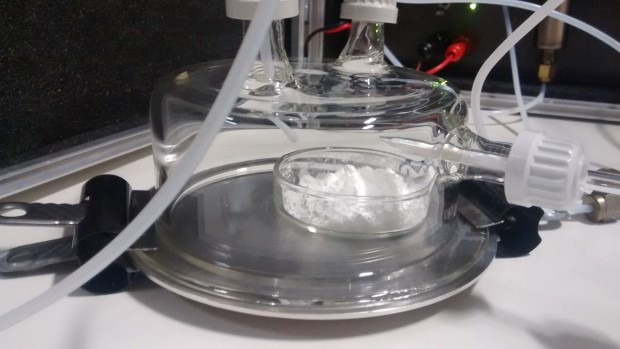Our innovative Agri-tech Catalyst project, led by the Processors and Growers Research Organisation (PGRO), is developing a “lure-and-kill” approach to manage agricultural pests. Currently blanket sprays of insecticide are used against the pea and bean weevil (Sitona lineatus) which attacks nitrogen fixing root nodules of field beans and peas and the bruchid beetle (Bruchus rufimanus) which severely reduces the saleable quality of field beans by burrowing holes in them. Instead of applying blanket sprays to the entire crop canopy, which is hard to penetrate and makes targeted application difficult, our vision is to lure the pests to a bait station containing small amounts of bioinsecticide which stick to the body of the pest. This will improve the targeting of the control measures and provide a much needed new solution because pyrethroid pesticide resistance is evolving in the pea and bean weevil.
For the project, BASF and Exosect are supplying isolates of entomopathogenic fungus (a naturally occurring fungal disease of insects). Exosect are formulating them with Entostat, an electrostatically charged micropowder they have developed, which sticks the fungi to the body of the pest. This can be used as a carrier for insecticides or bioinsecticides. Rothamsted have identified an aggregation pheromone specific for the pea and bean weevil which attracts both sexes and floral attractants for the bruchid beetle. These attractants will be formulated with the killing agent and placed strategically in inoculation stations in the field that we will develop with another project partner, Oecos.

Since the project started in October 2014, our first steps have been to determine and control the release rate of the attractants over time (a critical component of product longevity), and to determine the effectiveness of the different treatments in killing the pests. We have been measuring the release rate of the attractants by collecting them from air drawn over the test formulations. Odours collected on a filter are analysed by gas chromatography which allows us to quantify the amount of chemical released over a given time period. We are working with Exosect to improve the longevity of the product.

We have been testing in the lab the effectiveness of two strains of the insect fungal disease together with alpha-cypermethrin as a standard insecticide. Different doses of formulation have been put in Petri dishes and 10 beetles put in each dish. Numbers of dead insects are recorded at regular intervals for three weeks. The insect mortality results to date are encouraging and not only show that the insect fungal disease works but also that the effectiveness of the conventional insecticide is improved. Thus the components are being assembled for the “lure-and-kill” system.

We have also been testing field cages for the next stage when we do field cage trials which are planned for spring 2016. Parallel trials at Rothamsted and PGRO have shown that the cages provide good containment of the insects and therefore can be used to separate different treatments when we do the first small scale tests of the new system in outdoor conditions.

Our project will provide a new pest management solution (lure and kill) for beetle pests in pea and bean crops, a solution which may be transferable to other cropping systems. The benefits to the grower will be: increased pest control through a more targeted application of the insecticide; reduced use of insecticide per hectare; the option of different modes of killing agent which allows the product to be available to both conventional and organic growers; and as large volumes of water are not be required for uniform application, this product can be applied during periods of water shortages. There is an urgent need for new solutions due to pesticide resistance problems and concern about effects of pesticides on non-target species. The inoculation station with insect fungal disease would be a biological solution to the problem but lure-and-kill will also enable better targetting of conventional pesticides by using specific attractants to limit the classes of insects that come into contact with them.

5 comments
Comment by James Norton posted on
A "lure and kill" pest control method could become the norm in agriculture, because the benefits are countless. Other then efficiency, the biggest benefit is that it limits the spread of pesticides on crops. I have very limited knowledge in biology, but my experience in pest control poses me to ask a question - is it possible that the beetles develop a resistance to the new method as well? Or is that not possible with fungal diseases? I agree, however, that new alternative to pyrethroid pest control must be found. Keep us in the look, AgriTech!
James Norton, Consultant for http://www.fantasticpestcontrol.co.uk/
Comment by Toby Bruce posted on
There are indeed opportunities to improve targeting of killing agents by combining them with attractants and to avoid having to cover the whole crop in pesticide when using the “lure and kill” approach. It might be harder for beetles to evolve resistance to a fungal disease but if immunity to one particular strain of entomopathogenic fungus did evolve it would be quite straightforward to replace it with another more effective strain because there is a range of different strains of these fungi. We will keep you in the loop – our most recent finding was that formulations of the fungus can remain active for 4 months which is a big improvement compared to the longevity of a conventional insecticide treatment. We are also combining the lure and kill components and we need to improve the spread of the treatment beyond the inoculation stations… Best wishes, Toby
Comment by ricky Clark posted on
Targeted control for pests is already being undertaken in other sectors of the pest control industry and indeed government guidelines are now pushing for a lure and kill approach to mitigate the unintended consequences of pesticides and rodenticides, this is far more efficient as well as incredibly beneficial when it pertains to agricultural practices.Brilliant article!
Comment by Amber Morris posted on
"...lure-and-kill will also enable better targetting of conventional pesticides by using specific attractants to limit the classes of insects that come into contact with them."
This sounds fantastic.
But what about the other life stages of the beetle? Lure and kill will attract adult beetles, but what about the larvae? The eggs? Will this have to be used a couple of times in order to ensure the complete eradication of all life stages of the beetle?
"...increased pest control through a more targeted application of the insecticide; reduced use of insecticide per hectare;..."
It really does sound great. When it becomes available to the public a lot of people will benefit from this. That's the best direction science should go to- helping people. Thank you for all your work!
Comment by Daniel Neves posted on
During my degree at Edinburgh University they were also doing a lot of work on bio pest control for the agriculture. I wrote a paper and the main issue was also the release of the bacterial bio control agent overtime. In a fancy way, we had explored the possibility of using a bi-laminated component that would open up when in contact with water.
It was nice reading your article. Many thanks.